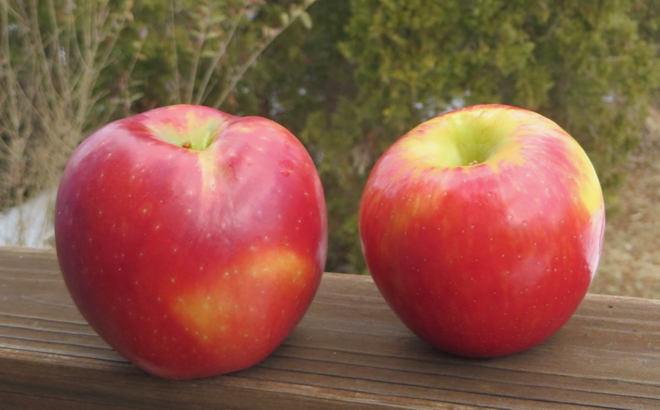

In one study, Golden Delicious takes the lead for its quercetin content, a compound that can reduce inflammation.

The article goes on to detail a variety of different studies comparing the concentration of specific phytochemicals between one apple variety to another. But don’t load your shopping basket with Fujis just yet. And it looks like the bargain Fuji really packs them in, while the Empire-a parent of the Cosmic Crisp-falls a bit short. These compounds act as antioxidants to help prevent an array of diseases. Red Delicious apples were also quite high, and the apples containing the lowest amounts of phenolics and flavonoids were the Empire apples and the NY647 apple.” …Out of 10 varieties commonly consumed in the US, Fuji apples had the highest total phenolic and total flavonoid compounds. According to the review article “Apple Phytochemicals and their Health Benefits” by Jeanelle Boyer and Rui Hai Liu (Nutrition Journal, May 2004) researchers “have found distinct differences in total phenolic and total flavonoid content between different apple varieties. Still, studies show there are differences between apple varieties.
#Cosmic crisp apple skin
“Red skin adds anthocyanins (pigments that give plants their color and also act as antioxidants when consumed) that green apples won’t have, but green apples are less sweet, so you get a slightly lower carbohydrate and calorie count-but not enough to get hugely excited about.” “The fiber content among apples is the same, about 5 grams per large apple,” says Lair. Although different varieties of apples do contain different levels and types of antioxidants, the overall nutritional differences among apple varieties is negligible. So, is it possible the Cosmic Crisp, with its deep red skin, is so nutritionally superior that it’s worth the extra few bucks? Probably not, says Cynthia Lair, adjunct professor in nutrition at Bastyr University. The plants are licensed and limited by WSU to only be sold to people residing and growing the plants in the state of Washington. This wasn’t a new Apple device, it was a new, well, apple. It hit stores across the nation with the kind of media fanfare usually reserved for mind-boggling game-changers and industry disrupters. Big, red, and stippled with fetching white freckles like stars in the night sky, the Cosmic Crisp mostly earns ink for blending great flavor with an easy-growing attitude. I bought a Cosmic Crisp apple (2.99 a pound) and a Honeycrisp apple (1.99 a pound) at Angelo Caputo’s market in Wheaton, IL.

But from a nutritional standpoint, are they worth the hype compared to other apples? It was designed to be a super apple of sorts, one that both growers and consumers would love. Its nerdy orchard name, WA 38, was cleverly replaced with a much more alluring, crowd-sourced moniker: Cosmic Crisp. More than 20 years in the making, the cross between the fabulously flavored Honeycrisp and the fabulously red Empire apples hit produce departments and food media sites with a garnet-hued splash. But this wasn’t a new Apple device, it was a new, well, apple. Second, the apple must be crisp and crunchy as well as. First, the apple needed to be able to thrive in Washington’s cool, rainy climate. Barritt and Evans had three main requirements. Afterward, carefully flip the bird over and stir the apples and onions to evenly coat them with rendered fat. The skin of the Cosmic Crisp has small freckles, called lenticels, which reminded focus group members of starry constellationshence the name 'Cosmic' Crisp. Īt the dawn of the last month of the decade, a new product hit stores across the nation with the kind of media fanfare usually reserved for mind-boggling game-changers and industry disrupters. Scatter the apple and onion wedges around the chicken. "It looks really nice - it's a very pretty apple.Danielle Centoni is a food writer and cookbook author based in Portland, Oregon. "Enterprise was chosen really because of its appearance," Evans said on the podcast Sporkful (via Smithsonian Magazine). The Honeycrisp gave the apple crispness with a sweet flavor, and the Enterprise gave it a longer shelf life, as well as its gorgeous color. In 1997, they began by taking the best parts of Honeycrisp and Enterprise apples. The best alternative Washington farmers could see was to develop their own variety (via America's Test Kitchen).īruce Barritt, a horticulturist, and Kate Evans, a pome fruit breeder, decided to create an apple that was crisp while still firm and juicy. Honeycrisp apples quickly became popular, but to grow them, farmers in Washington had to get licensing or a membership to a grower's club, both of which were expensive. Then, in 1991, the Honeycrisp apple was released by the University of Minnesota. Their main variety was Red Delicious, but in the 1990s, Washington started losing market share for their apples to other varieties, such as Fuji and Gala. The Cosmic Crisp apple is a variety that was developed in Washington State, which is the largest producer of apples in the U.S.


 0 kommentar(er)
0 kommentar(er)
